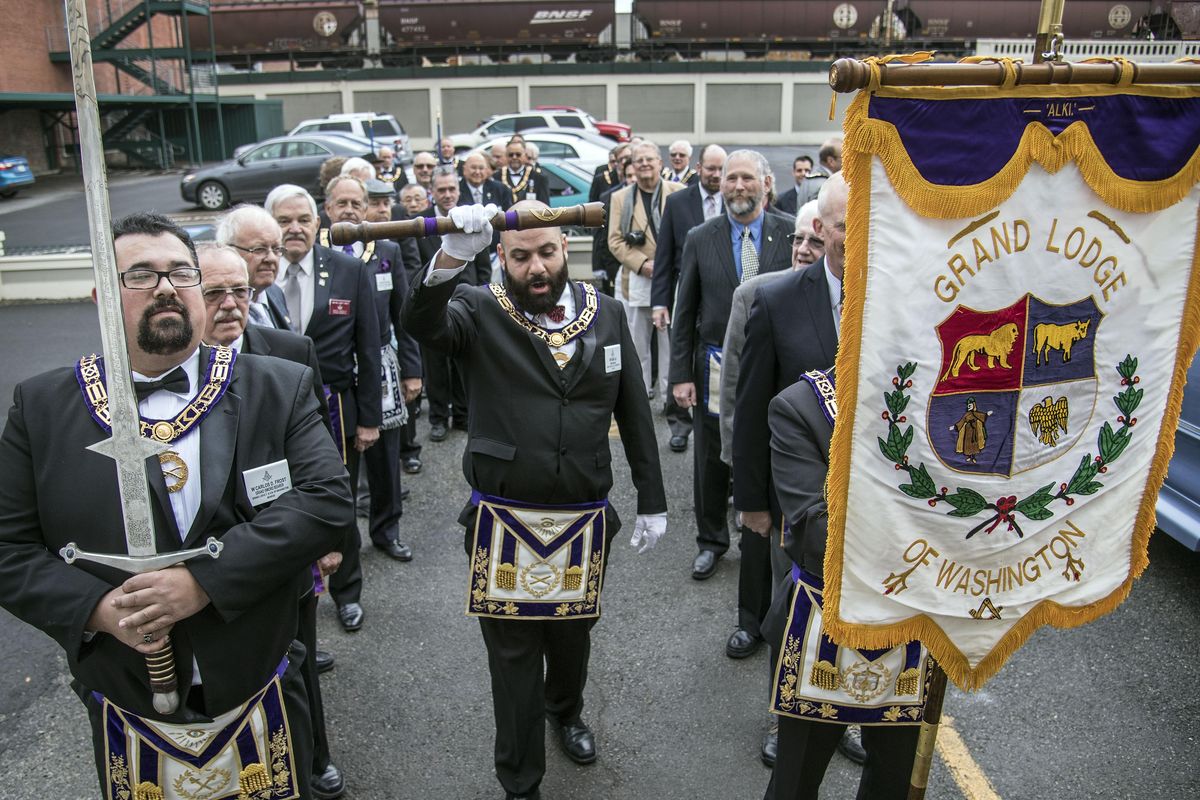Freemasons in Spokane move headquarters after nearly a century

A group of men are huddled in a half circle inside the cold walls of the decrepit Selkirk building downtown. Many of them are wearing ornate aprons embroidered in different colors and patterns. One man talks from behind a podium with a broadsword stuck in a piece of wood in front.
A large stone sits to his right – a ceremonial cornerstone in dedication of the new-old building that will soon house several chapters of Freemasons, called “lodges.”
One by one, the tools of Freemasonry – the square, level and plumb – are used to measure the stone and inspect its worth. Then, corn, wine and oil are poured on its surface.
“May the all boundless offer nature bless the inhabitants of this place with abundance of the necessaries, conveniences and comforts of life,” says Jim Mendoza, Grandmaster of the Freemasons of Washington. “And grant to us all a supply of the corn of nourishment, the wine of refreshment and the oil of joy.”
Upon hearing these words, the masons cross their chests with their arms, their hands outstretched; they look like mummies. They bow their heads: “so mote it be,” they say in unison. The stone is perfect.
Sometimes, this is what being a Freemason is – fraternity, with a little pomp and circumstance. It’s much less exciting than the pop culture image of Freemasonry: Nicholas Cage in the “National Treasure” film franchise hunting down a fabulous hidden treasure stashed by the Founding Fathers – many of them Freemasons.
In reality, Freemasons are closer to a college fraternity (without all of the “buffoonery,” they jokingly say) than an all-powerful secret society. There are rules, expectations, a strong sense of community, and a deep history spanning as far back as the 14th century.
There are also many powerful and historical figures among their ranks: George Washington, Paul Revere, Theodore Roosevelt, John Elway and Steve Wozniak, the Apple co-founder, to name a few.
In Washington, Freemasonry began in 1858, and in Spokane, around 1880 – when settlers first arrived to the area. The first lodge was formed not long after. In 1910, there were enough masons to warrant their own building – the Masonic Center on Riverside Avenue (Theodore Roosevelt was present for the groundbreaking).
They stayed there for a century, until it was sold in 2013. The center was too large, and the amenities in too much disrepair to afford. The lodges headquartered there moved in with other lodges, with a plan to move out once the new center is complete. The ceremony Saturday was one of the last steps before construction and repair go into full swing at 506 W. Second Ave.
Many of the windows are boarded, and the walls have large, gaping holes exposing the outside. Several sections of the first floor are unfinished, showing the earthy foundation sitting underneath. Rather than move into a finished building, tradition is to either build a new one or find one that could use some tender love and care.
“We like to fix things up better than we found them,” said Richard Coffland, a deputy grandmaster.
By early next year, the space will look a lot different. The plan is to knock down the rusted metal beams on the first floor; the space will be shared by Spokane Lodge 34, Oriental 74 and North Hill 210. On the top floor will be a masonic museum and library preserving the storied history of Freemasonry in Spokane.
The second floor will be shared by the Scottish Rite, another branch of masonry, and Early Life Speech and Language clinic, which provides free research-based therapy for children ages 2 to 7.
Ashley Miller, the clinic’s development officer, said half of the second floor of the new masonic building was offered as a permanent home to the nonprofit. For the past two years, Freemasons have remained one of the clinic’s top supporters, having just put on a large golf tournament to raise funds.
“They’re always looking for ways to help us grow,” Miller said.
It’s self-improvement and improving the community, Freemasons say, that is the essence of being a Freemason – not necessarily the complex ceremonies or ornate dress codes. For hundreds of years, masons have donated to their communities, helped construct new buildings and repaired old ones. And all the while, they’ve lectured the fraternity is more about building human character than anything.
“In that sense, we are all architects,” Mendoza said.
As for conspiracy theories about Freemasons controlling the United States government, having ties to the Illuminati, or stashing treasure as portrayed in Hollywood blockbusters?
“I find it to be very humorous,” Mendoza said. “I look at it this way: I attend many of the lodge meetings where they argue over who’s going to bring condiments to the barbecue.”